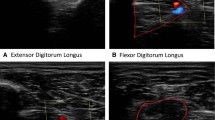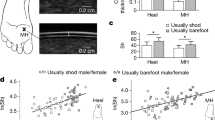Abstract
Foot orthoses (FO) are a commonly prescribed intervention to alter foot function during walking although their effects have been primarily studied in the extrinsic muscles of the foot. Furthermore, enhancing sensory feedback under the foot sole has been recently shown to alter extrinsic muscle activity during gait; however, the effects of FOs with enhanced sensory feedback on plantar intrinsic foot muscles (PIFMs) remain unknown. Thus, the purpose of this study was to investigate the effect of FOs with and without sensory facilitation on PIFM activity during locomotion. Forty healthy adults completed a series of gait trials in non-textured and textured FOs when walking over hard and soft flooring. Outcome measures included bilateral joint kinematics and electromyography (EMG) of four PIFMs. Results of this study highlight the distinct onset and cessations of each PIFM throughout the stance phase of gait. PIFMs remained active during mid-stance when wearing FOs and textured FOs facilitated muscle activity across the stance phase of gait. Increasing cutaneous input from foot sole skin, via the addition of texture under the foot sole, appears to alter motor-neuron pool excitation of PIFMs. Future academics are encouraged to increase our understanding on which pathologies, diseases, and/or medical conditions would best benefit from textured FOs.








Similar content being viewed by others
Data availability
The datasets generated during and/or analyzed during the current study are available from the corresponding author on reasonable request.
References
Ackerley R, Watkins RH (2018) Microneurography as a tool to study the function of individual C-fiber afferents in humans: Responses from nociceptors, thermoreceptors, and mechanoreceptors. J Neurophysiol 120:2834–2846. https://doi.org/10.1152/jn.00109.2018
Choi JK, Cha EJ, Kim KA et al (2015) Effects of custom-made insoles on idiopathic pes cavus foot during walking. Biomed Mater Eng 26:S705–S715. https://doi.org/10.3233/BME-151362
Farris DJ, Kelly LA, Cresswell AG et al (2019a) The functional importance of human foot muscles for bipedal locomotion. Proc Natl Acad Sci USA 116:1645–1650. https://doi.org/10.1073/pnas.1812820116
Farris DJ, Kelly LA, Cresswell AG, Lichtwark GA (2019b) The functional importance of human foot muscles for bipedal locomotion. Proc Natl Acad Sci USA 116:1645–1650. https://doi.org/10.1073/pnas.1812820116
Farris DJ, Birch J, Kelly L (2020) Foot stiffening during the push-off phase of human walking is linked to active muscle contraction, and not the windlass mechanism. J R Soc Interface. https://doi.org/10.1098/rsif.2020.0208rsif20200208
Fuglkjær S, Dissing KB, Hestbæk L (2017) Prevalence and incidence of musculoskeletal extremity complaints in children and adolescents. A systematic review. BMC Musculoskelet Disord. https://doi.org/10.1186/s12891-017-1771-2
Hamill J, Knutzen KM, Derrick TR (2015) Angular kinematics. Biomechanical basis of human movement, 4th edn. Lippincott Williams & Wilkins, Philadelphia, pp 318–345
Headlee DL, Leonard JL, Hart JM et al (2008) Fatigue of the plantar intrinsic foot muscles increases navicular drop. J Electromyogr Kinesiol 18:420–425. https://doi.org/10.1016/j.jelekin.2006.11.004
Jamali A, Forghany S, Bapirzadeh K, Nester CJ (2019) The effect of three different insoles on ankle movement variability during walking in athletes with functinpoal ankle instability. Adv Biomed Res 6:1–13. https://doi.org/10.4103/abr.abr
Johnson KO (2001) The roles and functions of cutaneous mechanoreceptors. Curr Opin Neurobiol 11:455–461
Kelly LA, Racinais S, Cresswell AG (2013) Discharge properties of abductor hallucis before, during, and after an isometric fatigue task. J Neurophysiol 110:891–898. https://doi.org/10.1152/jn.00944.2012
Kelly LA, Lichtwark G, Cresswell AG, Cresswell AG (2015) Active regulation of longitudinal arch compression and recoil during walking and running. J R Soc Interface 12:20141076
Kelly LA, Lichtwark GA, Farris DJ, Cresswell A (2016) Shoes alter the spring-like function of the human foot during running. J R Soc Interface. https://doi.org/10.1098/rsif.2016.0174
Kenny RPW, Atkinson G, Eaves DL et al (2019) The effects of textured materials on static balance in healthy young and older adults: a systematic review with meta-analysis. Gait Posture 71:79–86. https://doi.org/10.1016/j.gaitpost.2019.04.017
MacLellan MJ, Patla AE (2006) Adaptations of walking pattern on a compliant surface to regulate dynamic stability. Exp Brain Res 173:521–530. https://doi.org/10.1007/s00221-006-0399-5
Maharaj JN, Cresswell AG, Lichtwark GA (2018) The immediate effect of foot orthoses on subtalar joint mechanics and energetics. Med Sci Sport Exerc 50:1449–1456. https://doi.org/10.1249/MSS.0000000000001591
Maharaj JN, Kessler S, Rainbow MJ et al (2020) The reliability of foot and ankle bone and joint kinematics measured with biplanar videoradiography and manual scientific rotosco**. Front Bioeng Biotechnol 8:1–11. https://doi.org/10.3389/fbioe.2020.00106
Mann R, Inman VT (1964) Phasic activity of intrinsic muscles of the foot. J Bone Jt Surg 46-A:469–481
Marigold DS, Patla AE (2005) Adapting locomotion to different surface compliances: neuromuscular responses and changes in movement dynamics. J Neurophysiol 94:1733–1750. https://doi.org/10.1152/jn.00019.2005
Moisan G, Descarreaux M, Cantin V (2018) Muscle activation during fast walking with two types of foot orthoses in participants with cavus feet. J Electromyogr Kinesiol 43:7–13. https://doi.org/10.1016/j.jelekin.2018.08.002
Moore KL, Dalley AF, Agur AMR (2018) Lower limb. Clinically oriented anatomy, 8th edn. Wolters Kluwer, Philadelphia, pp 666–828
Murley GS, Menz HB, Landorf KB (2009) Foot posture influences the electromyographic activity of selected lower limb muscles during gait. J Foot Ankle Res 2:1–9. https://doi.org/10.1186/1757-1146-2-35
Nurse MA, Hulliger M, Wakeling JM et al (2005) Changing the texture of footwear can alter gait patterns. J Electromyogr Kinesiol 15:496–506. https://doi.org/10.1016/j.jelekin.2004.12.003
Oh-Park M, Kirschner J, Abdelshahed D, Kim DDJ (2019) Painful foot disorders in the geriatric population: a narrative review. Am J Phys Med Rehabil 98:811–819. https://doi.org/10.1097/PHM.0000000000001239
Pearcey GEP, Zehr EP (2019) We are upright-walking cats: human limbs as sensory antennae during locomotion. Physiology 34:354–364. https://doi.org/10.1152/physiol.00008.2019
Purves D, Augustine GJ, Fitzpatrick D et al (2018) Lower motor neuron circuits and motor control. Neuroscience, 6th edn. Oxford University Press, pp 357–379
Riddick R, Farris DJ, Kelly LA, Riddick R (2019) The foot is more than a spring : human foot muscles perform work to adapt to the energetic requirements of locomotion. R Soc. https://doi.org/10.1098/rsif.2018.0680
Robb KA, Perry SD (2019) Textured foot orthotics on dynamic stability and turning performance in Parkinson’s disease. J Mot Behav. https://doi.org/10.1080/00222895.2019.1639609
Robb KA, Perry SD (2022) The effect of texture under distinct regions of the foot sole on human locomotion. Exp Brain Res. https://doi.org/10.1007/s00221-022-06402-x
Robb KA, Hyde JD, Perry SD (2021a) The role of enhanced plantar-surface sensory feedback on lower limb EMG during planned gait termination. Somatosens Mot Res 38:146–156. https://doi.org/10.1080/08990220.2021.1904870
Robb KA, Melady HD, Perry SD (2021b) Fine-wire electromyography of the transverse head of adductor hallucis during locomotion. Gait Posture 85:7–13. https://doi.org/10.1016/j.gaitpost.2020.12.020
Rodgers MM (1988) Dynamic biomechanics of the normal foot and ankle during walking and running. Phys Ther Rehabil J 68:1822–1830
Sheffield F, Gersten J, Mastellone A (1956) Electromyographic study of the muscles of the foot in normal walking. Am J Phys Med 35:223–236
Sheykhi-dolagh R, Saeedi H, Farahmand B et al (2015) The influence of foot orthoses on foot mobility magnitude and arch height index in adults with flexible flat feet. Prosthet Orthot Int 39:190–196. https://doi.org/10.1177/0309364614521652
Strzalkowski NDJ, Peters RM, Inglis JT, Bent LR (2018) Cutaneous afferent innervation of the human foot sole: what can we learn from single-unit recordings? J Neurophysiol 120:1233–1246. https://doi.org/10.1152/jn.00848.2017
Welte L, Kelly LA, Lichtwark GA, Rainbow MJ (2018) Influence of the windlass mechanism on arch-spring mechanics during dynamic foot arch deformation. J R Soc Interface. https://doi.org/10.1098/rsif.2018.0270
Winter DA, Yack HJ (1987) EMG profiles during normal human walking: stride-to-stride and inter-subject variability. Electroencephalogr Clin Neurophysiol 67:402–411. https://doi.org/10.1016/0013-4694(87)90003-4
Zehr EP, Stein RB (1999) What functions do reflexes serve during human locomotion? Prog Neurobiol 58:185–205. https://doi.org/10.1016/S0301-0082(98)00081-1
Zehr EP, Nakajima T, Barss T et al (2014) Cutaneous stimulation of discrete regions of the sole during locomotion produces “sensory steering” of the foot. BMC Sports Sci Med Rehabil 6:1–23. https://doi.org/10.1186/2052-1847-6-33
Zelik KE, La Scaleia V, Ivanenko YP, Lacquaniti F (2015) Coordination of intrinsic and extrinsic foot muscles during walking. Eur J Appl Physiol 115:691–701. https://doi.org/10.1007/s00421-014-3056-x
Acknowledgements
This work was supported by the Natural Science and Engineer Research Council of Canada (NSERC) Discovery Grant [RGPIN-2015-06481] and the Canadian Foundation for Innovation [5141].
Funding
This work was supported by the Pedorthic Research Foundation of Canada, the Natural Science and Engineer Research Council of Canada (NSERC) Discovery Grant [RGPIN-2015-06481] and the Canadian Foundation for Innovation [5141].
Author information
Authors and Affiliations
Corresponding author
Ethics declarations
Conflict of interest
Stephen Perry holds a patent for a balance-enhancing insole (Maki, Perry, McIlroy, US 6,237,256 B1, 2001) and is the CEO of Balancepro, Inc. that is involved in the commercialization of the ‘Balancepro’ insole. Kelly Robb is a Canadian Certified Pedorthist, has submitted a patent for a textured insole (CAN, US Patent Offices, 2020), and has intention of using textured foot orthotics in future clinical practice.
Additional information
Communicated by Francesco Lacquaniti.
Publisher's Note
Springer Nature remains neutral with regard to jurisdictional claims in published maps and institutional affiliations.
Supplementary Information
Below is the link to the electronic supplementary material.
Rights and permissions
Springer Nature or its licensor (e.g. a society or other partner) holds exclusive rights to this article under a publishing agreement with the author(s) or other rightsholder(s); author self-archiving of the accepted manuscript version of this article is solely governed by the terms of such publishing agreement and applicable law.
About this article
Cite this article
Robb, K.A., Perry, S.D. Capitalizing on skin in orthotics design: the effects of texture on plantar intrinsic foot muscles during locomotion. Exp Brain Res 242, 403–416 (2024). https://doi.org/10.1007/s00221-023-06758-8
Received:
Accepted:
Published:
Issue Date:
DOI: https://doi.org/10.1007/s00221-023-06758-8




